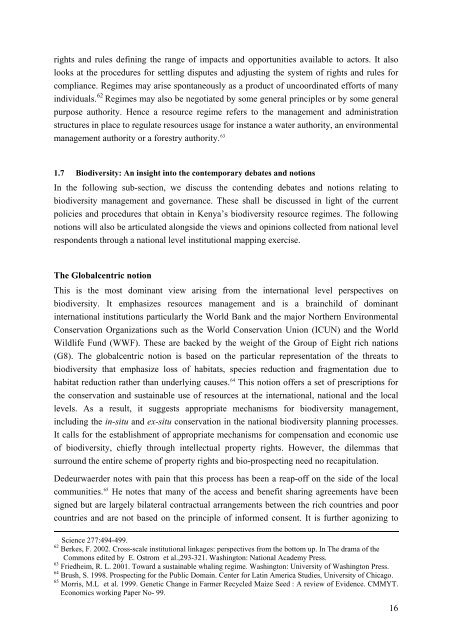THE UNIVERSITY OF LEIPZIG
THE UNIVERSITY OF LEIPZIG
THE UNIVERSITY OF LEIPZIG
Create successful ePaper yourself
Turn your PDF publications into a flip-book with our unique Google optimized e-Paper software.
ights and rules defining the range of impacts and opportunities available to actors. It also<br />
looks at the procedures for settling disputes and adjusting the system of rights and rules for<br />
compliance. Regimes may arise spontaneously as a product of uncoordinated efforts of many<br />
individuals. 62 Regimes may also be negotiated by some general principles or by some general<br />
purpose authority. Hence a resource regime refers to the management and administration<br />
structures in place to regulate resources usage for instance a water authority, an environmental<br />
management authority or a forestry authority. 63<br />
1.7 Biodiversity: An insight into the contemporary debates and notions<br />
In the following sub-section, we discuss the contending debates and notions relating to<br />
biodiversity management and governance. These shall be discussed in light of the current<br />
policies and procedures that obtain in Kenya’s biodiversity resource regimes. The following<br />
notions will also be articulated alongside the views and opinions collected from national level<br />
respondents through a national level institutional mapping exercise.<br />
The Globalcentric notion<br />
This is the most dominant view arising from the international level perspectives on<br />
biodiversity. It emphasizes resources management and is a brainchild of dominant<br />
international institutions particularly the World Bank and the major Northern Environmental<br />
Conservation Organizations such as the World Conservation Union (ICUN) and the World<br />
Wildlife Fund (WWF). These are backed by the weight of the Group of Eight rich nations<br />
(G8). The globalcentric notion is based on the particular representation of the threats to<br />
biodiversity that emphasize loss of habitats, species reduction and fragmentation due to<br />
habitat reduction rather than underlying causes. 64 This notion offers a set of prescriptions for<br />
the conservation and sustainable use of resources at the international, national and the local<br />
levels. As a result, it suggests appropriate mechanisms for biodiversity management,<br />
including the in-situ and ex-situ conservation in the national biodiversity planning processes.<br />
It calls for the establishment of appropriate mechanisms for compensation and economic use<br />
of biodiversity, chiefly through intellectual property rights. However, the dilemmas that<br />
surround the entire scheme of property rights and bio-prospecting need no recapitulation.<br />
Dedeurwaerder notes with pain that this process has been a reap-off on the side of the local<br />
communities. 65 He notes that many of the access and benefit sharing agreements have been<br />
signed but are largely bilateral contractual arrangements between the rich countries and poor<br />
countries and are not based on the principle of informed consent. It is further agonizing to<br />
Science 277:494-499.<br />
62<br />
Berkes, F. 2002. Cross-scale institutional linkages: perspectives from the bottom up. In The drama of the<br />
Commons edited by E. Ostrom et al.,293-321. Washington: National Academy Press.<br />
63<br />
Friedheim, R. L. 2001. Toward a sustainable whaling regime. Washington: University of Washington Press.<br />
64<br />
Brush, S. 1998. Prospecting for the Public Domain. Center for Latin America Studies, University of Chicago.<br />
65<br />
Morris, M.L et al. 1999. Genetic Change in Farmer Recycled Maize Seed : A review of Evidence. CMMYT.<br />
Economics working Paper No- 99.<br />
16






